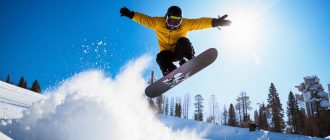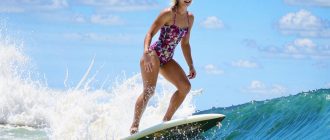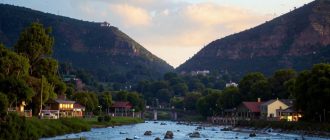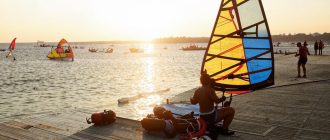One of the most popular water activities can rightfully be called wakeboarding – riding a board on the water behind a boat or with the help of a winch pull. Many people often confuse wakeboarding with wakesurfing (we are no exception). Despite the colossal differences, it’s true that such an oversight does happen.
Below you can find the history of wakeboarding, the differences between the two and discover that you can ride even in cold weather. Here we go.
How wakeboarding came to be
Putting aside the lyrics, the starting point of wakeboarding is considered to be 1985 and the “scurfer”, an invention of the hands of Tony Fina from San Diego. This miracle looked like a small surf, and the ride itself resembled snowboarding or skateboarding. Tony attached straps to the board, which allowed him to do tricks using the waves as a springboard.
Being an ardent fanatic of his invention, Fin tried his best to lobby for the scarfer, which eventually led to the first competition in 1990. And all would have been well, but the complex riding technique and excessive buoyancy of the board were difficult for beginners to master. As a result, the popularization of the new “sport” slowed down.
Around the same period Herb O’Brien, owner of the water-skiing company H.O.. Sports, began experimenting with the creation of skateboards and eventually showed the world his hyperlite. His innovation had a neutral buoyancy, which allowed the board to “sink” and launch more easily out of the water. Herb didn’t stop there and continued his experiments, which led to the board getting a thin profile and a special shape of the glide – its lower surface. This made it possible to “cut” turns while moving and absorb energy from water impacts. Competitors decided not to lag behind the new market leader and also began to make boards. Further wakeboarding began to develop as a real sport of the highest achievements.
In 1993, thanks to Jimi Redmon, wakeboards went from a surf shape to a symmetrical twin-tip. Along with this, Wake Boarding magazine began to be published. Wakeboarding was gaining so much popularity that in 1998 the Greek Olympic Committee recommended that the IOC make it an Olympic discipline at the 2004 Athens Games. Subsequently, there have been several more attempts, with the most recent one taking place in 2019. Unfortunately, the IOC decided not to include wakeboarding in the Paris 2024 Games.

What’s important to know about wakeboarding
Highlights

Wakeboarding world vice-champion
You can try wakeboarding at a wakepark in your city. You can always rent equipment and a coach on site. We have a friendly community, and everyone is stoked for the development of the sport, so don’t be shy to ask for help – they will always help and advise you. I would also like to note that special training is absolutely not required, but if you already stand on any boards – snowboard, skateboard, surf – it will be a big plus.
Our sport can be divided into two directions: cable wakeboarding and boat wakeboarding.
Cable wakeboarding is riding behind a special rig (winch). Riders ride on different shapes, rails, pipes, jump off the kicker (springboard) and perform tricks from the water.
Rides are usually at wakeparks, and in turn, they are divided into:
- reversible – consists of two supports, you will ride back and forth;
- circular – usually this setup takes up a whole body of water, and in fact you ride in a circle.
Boat wakeboarding – involves riding behind a special boat, which creates a wave – from it and it is necessary to jump and perform tricks.
There is also wakeboarding with a portable winch (winch). But it is designed only for professionals, as it is very dangerous and you need a good experience of riding. In fact, it is street skating on rivers, canals and other urban water bodies.
Wakeboarding and wakesurfing are not the same thing
Wakeboarding and wakesurfing have only the first four letters in common. To be honest, I’m constantly shocked when people aspire to go wakeboarding and yet say, “I’m going wakeboarding.” It’s the same as if they were saying they’re going surfing.
Let’s start with the fact that wakesurfing is not an extreme sport and the possibility of serious injury is minimized. In boat wakeboarding and wakesurfing people ride on the wave, which is created by a special boat. Everything else is different – the wave, the boards and the tricks. A wakesurf board is similar to a mini-surf and has no bindings, unlike a wakeboard.
You can read more about the differences between the two boards here:
What Equipment Should Be
For the first few training sessions, you can use rental equipment: it is available in every park. But, of course, it’s no match for your own. If you want to keep on riding and progressing, you should buy your own equipment.
Equipment for wakeboarding consists of:
- board;
- bindings;
- vest;
- helmet;
- wetsuit (depending on weather conditions).
When choosing a board, you should pay attention to its length and shape. The length should be adjusted to your height, weight and level of riding. For example, longer boards are in fashion nowadays, but you should not abuse it too much. The industry offers a huge range of shaping options and you will definitely find something for you.
At first I wouldn’t worry too much about shaping, because it’s hard to feel the difference. Prefer a lighter board and one that has ridges on the glide (small ridges on the back of the board. – Editor’s note) to help you better control the board on the water.
Bindings are easy. Just make sure they fit your board and you can screw them on. Then just try them on and choose what is most comfortable for you. With a helmet and vest it’s basically the same.
The wetsuit is a bit more complicated. Its thickness should be selected depending on the weather in which you will ride. As an option, take a long wetsuit with a thickness of 3/2 mm – this is the golden mean, proven by personal experience.

Whether you can ski in winter
There are several options. Either go to a warm place: Thailand, Philippines, Bali… or continue to ride in the winter pool. This is a godsend for those who can’t go abroad.
The guys put a small reversible winch right in a real pool, like Kingwinch Pool in St. Petersburg or SportStation in Moscow. These are great places to keep riding in the winter and sharpen your technique. By the way, it was Russia that thought of this.
Don’t put off your desire to try wakeboarding for the next season, especially since the weather is still favorable. The most important thing – do not hesitate to ask for help, and the best thing is to take a coach at least for the first few lessons. This will help you to get more pleasure from the riding itself and maximum understanding of what is necessary and possible to do on a wakeboard.






